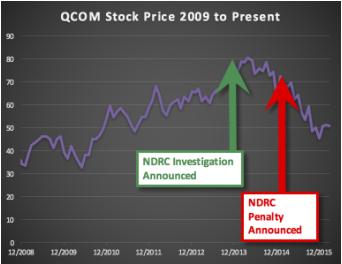Qualcomm Forced to Sue Chinese Handset-Maker Meizu to Protect Its Licensing Stream in China6/28/2016  Qualcomm operates through two major segments: QCT (Qualcomm CDMA Technologies), which primarily manufactures wireless semiconductors. The other functional segment is QTL (Qualcomm Technology Licensing), which licenses Qualcomm’s patents to handset makers in return for royalty payments. On the business side, QCT adds around 67% to overall revenue but accounts for only about 25% of operating income. QTL, on the other hand, contributes only 31% toward revenue but earns approximately 75% of operating income. Another way of saying this, is that Qualcomm makes around two-thirds of its profits from patent licensing. In addition to patents, another area important to Qualcomm in China. The country is very important to Qualcomm for several reasons. For one, Qualcomm in 2015 received 53% of its revenue from China. Additionally, Qualcomm has had significant troubles over the last few years in China. In mid-November, 2013, the NDRC (National Development and Reform Commission) investigators raided Qualcomm Beijing and Shanghai. On December 13, the NDRC announced it was investigating Qualcomm for violating China’s 2007 AML (Anti-monopoly Law). Qualcomm made several strategic mistakes related to the NDRC investigation. First, they did not find out about it as early as it should have. They should have had more government affairs people on the ground in Beijing talking every few days with their contacts at the major government agencies, including the NDRC. Had Qualcomm found out earlier that Chinese handset makers were complaining to the government about the royalty rates they had to pay Qualcomm, there would have been an opportunity to solve the problem before the investigation even became public. This would have been particularly important given that the Chinese investigation led to similar investigations in S. Korea, Taiwan, the EU, and even the US. Also, Qualcomm reacted poorly to the investigation, and was very aggressive. Instead of being conciliatory and respectful, Qualcomm challenged the NDRC at every turn, and even enlisted the US government to publicly chastise China for improperly using its anti-monopoly laws. Publicly poking China in the eye has never led to success, and it did not here. It was only when Qualcomm changed its tune regarding the investigation and adopted an attitude of asking what it could do to help solve the problem that a settlement was worked out. That settlement Qualcomm included a $975M fine, but the more significant penalties were the the royalty rates it received from Chinese companies operating in China. The agreement applied only to phones sold in China by companies based in China. Under the settlement, Qualcomm said it will offer separate licenses for certain patents, with licensees paying 3.5% for devices using only its 4G technology and 5% for 3G-only devices or those that use both cellular technologies. That was a significant cut from prior rates. But in addition to the rates being cut, so was the based to which those rates are applied. Instead of applying the percentage to the wholesale price of the handset, Qualcomm now applies it to 65% of the net selling price of a device, a lower figure than the wholesale price. So there are three decreases: (A) the rate, (B) the net selling price instead of the wholesale price, and (C) getting only 65% (of the wholesale price). The effect of this on Chinese domestic handset makers is that they have a huge home-field advantage over foreign companies regarding phones sold in China because they get Qualcomm chips for a huge discount compared to what Qualcomm charges non-Chinese companies not covered by the NDRC settlement. The effect on Qualcomm is a huge hit to its Chinese revenue, and therefore its overall revenue since it gets more than half of its revenue from China. A final problem for Qualcomm in China is that it has had some trouble getting some handset makers to pay to license its patents. Although Qualcomm has a majority of the mobile chip market, because of the NDRC investigation, it lost a lot of leverage in licensing negotiations. Qualcomm now had a black eye in China, and was arguably seen as having acted unfairly to Chinese companies. While I personally disagree with this, the fact remains that to succeed in China, foreign companies must be considered to be friends of China, and Qualcomm is not now a great friend. When Meizu held out and refused to pay royalties, it presented Qualcomm with a dilemma. Should it sue Meizu and risk being seen as a problem again to the Chinese government, or should it wait and continue to negotiate. Given that the margins in China had gone down so much, and because Qualcomm has tried to make amends with China, Qualcomm felt like it had no choice but to try to leverage payment via litigation. This is very important to Qualcomm’s future in China, and to the company at large. If it cannot force a company to pay it royalties, Qualcomm’s licensing model is destroyed – at least in China. Further, this case is important to the entire Chinese patent system. Qualcomm is well-known to have an extremely strong patent portfolio – the best patent portfolio in the mobile industry – and if it cannot secure a litigation win or force a settlement based on the newly improved Chinese patent enforcement system, it will be a setback for the Chinese courts and ultimately, China itself. This is because foreign companies will lose some faith in a court system that has increasingly proven itself very efficient, effective, and fair in adjudicating patent disputes in China. Since Qualcomm is “supposed to win” this case, if it does not, the entire patent enforcement system in China is called into doubt. I suspect that Meizu will settle the case either before or after trial, but before appeal. But I have no crystal ball. What I do know is that if Qualcomm does not win, its success in China will be severely impinged. Leave a Reply. |
Welcome to the China Patent Blog by Erick Robinson. Erick Robinson's China Patent Blog discusses China's patent system and China's surprisingly effective procedures for enforcing patents. China is leading the world in growth in many areas. Patents are among them. So come along with Erick Robinson while he provides a map to the complicated and mysterious world of patents and patent litigation in China.
AuthorErick Robinson is an experienced American trial lawyer and U.S. patent attorney formerly based in Beijing and now based in Texas. He is a Patent Litigation Partner and Co-Chair of the Intellectual Property Practice at Spencer Fane LLP, where he manages patent litigation, licensing, and prosecution in China and the US. Categories
All
Archives
February 2021
Disclaimer: The ideas and opinions at ChinaPatentBlog.com are my own as of the time of posting, have not been vetted with my firm or its clients, and do not necessarily represent the positions of the firm, its lawyers, or any of its clients. None of these posts is intended as legal advice and if you need a lawyer, you should hire one. Nothing in this blog creates an attorney-client relationship. If you make a comment on the post, the comment will become public and beyond your control to change or remove it. |





 RSS Feed
RSS Feed